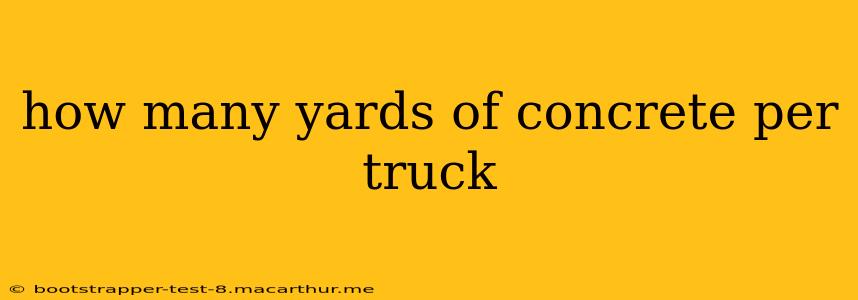How Many Yards of Concrete Per Truck? A Comprehensive Guide
The question "How many yards of concrete per truck?" doesn't have a single, simple answer. The amount of concrete a cement mixer truck can carry varies significantly depending on several key factors. This comprehensive guide will break down these factors and help you accurately estimate the concrete volume you'll need for your project.
What Size are Concrete Mixer Trucks?
Concrete mixer trucks, also known as cement mixers or ready-mix trucks, come in a variety of sizes. The most common sizes are measured in cubic yards, and the capacity generally ranges from 7 to 10 cubic yards. However, you can find smaller and larger trucks as well, depending on the needs of the job site and the contractor's equipment.
Factors Affecting Concrete Truck Capacity
Several factors influence the actual amount of concrete a truck can carry on any given day:
- Truck Size: As mentioned, truck size is the primary factor. A larger truck obviously carries more concrete.
- Type of Mixer: Different mixer designs might slightly alter the usable volume.
- Load Weight Restrictions: Local regulations and road weight limits can restrict the amount of concrete a truck can legally carry. Overloaded trucks pose safety hazards.
- Aggregates: The specific mix design (the ratio of cement, sand, gravel, and water) affects the overall density of the concrete. Heavier aggregates will result in a slightly smaller volume per truckload.
- Water Content: Higher water content in the mix results in a less dense mix and therefore a higher volume in the same weight. However, this impacts the concrete's strength.
How Much Concrete Do You Need?
Determining the exact amount of concrete needed for your project requires careful planning:
-
Calculate Cubic Yardage: Measure the dimensions (length x width x depth) of the area to be poured, in feet. Convert the cubic feet to cubic yards by dividing by 27 (since there are 27 cubic feet in a cubic yard).
-
Account for Waste: Add 5-10% extra to your calculated amount to account for spillage, waste, and potential errors in measurement.
-
Consult a Professional: For complex projects, it's best to consult with a concrete contractor. They can accurately estimate the required amount, factoring in all relevant variables. They can also advise on the most efficient way to deliver and place the concrete.
What are the Different Types of Concrete Mixers?
While the size is a major determining factor, there are also different types of concrete mixers which will affect the capacity. These include:
- Transit Mixers: These are the most common type of concrete mixer used for construction projects. They are large trucks with rotating drums that mix the concrete while it is being transported. Capacity varies, as noted above.
- Small Mixers: For smaller projects, smaller, portable mixers are available. These typically hold much less concrete and are more suitable for DIY or small-scale jobs.
How Much Does a Truckload of Concrete Cost?
The cost of a truckload of concrete varies widely depending on location, the type of concrete, and the distance the concrete needs to be transported. It's best to get multiple quotes from local concrete suppliers to determine the price in your area.
Can I Order Less Than a Full Truckload?
You can often order less than a full truckload, but it may cost more per cubic yard due to the added logistical challenges for the supplier. Check with your supplier for their minimum order requirements.
By considering these factors, you can get a much clearer understanding of how many yards of concrete a truck can hold and accurately estimate the quantity needed for your project. Remember, accurate planning and consulting with professionals are crucial for successful concrete projects.
